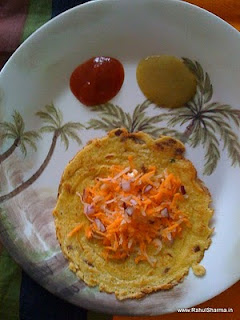What’s your ideal breakfast?
Will it be parathas, muesli or eggs for breakfast? Indrani Rajkhowa Banerjee explores options for the most balanced meal to start your day
TIMES NEWS NETWORKCRAVING parathas for breakfast but the calorie content scares you off ? Or is rolling dough too cumbersome? For a generation on the go, breakfast, considered the most important meal of the day, has been lost in a flurry of “expert tips” doled out by health magazines and videos. It has no fixed timings and no fixed palate. If it’s muesli one day, it’s poori-sabzi the next. With so many do’s and don’ts, where do you look for advice? Although the preferred palate for breakfast remains Indian, inertia and health fads let convenience take precedence over health benefits.
We know the awful things a skipped breakfast can do to our body, but the question is of rustling up the ideal morning meal. One quick tip, say nutritionists, is to “strive for five”. Include at least five grams of fibre and five grams of protein in every breakfast. Here, your options are many. The markets are flooded with a variety of canned and packaged foods — from readymade poha to frozen hams and sausages. There’s nothing that you can’t have! However, some wise judgment on your part will help.
Most fitness experts and dieticians vouch for the goodness of a freshlychopped and cooked
morning meal over packaged food. Says Honey Khanna, nutritionist, Max Healthcare, “Packaged cereals have sugar granules, which can harm diabetics or weight watchers.”
Though Indians generally prefer to drink tea or coffee with the first meal of the day, a glass of canned juice is fast replacing traditional drinks. “Packaged juice,” according to Dr Sunita Roy Chowdhury, chief nutritionist, Rockland Hospital, “has empty calories; it consists of just sugar and water.”
Go for freshly squeezed juice. Even better is a bowl of freshly cut fruits, because fruits lose their fibre content when turned into juice. If you are a hardcore muesli and oats person, take a cue from actor and fitness expert Rahul Dev. His mom believes in serving homemade porridges which she roasts and grinds at home. When it comes to the traditional Indian breakfast, the general consensus is that it’s time-consuming, oily and fatty, but tasty! Restaurateur Shiv Karan Singh has an interesting observation, “Indians love to fill themselves. And not many can live without a hearty traditional breakfast, Indian or English. The newfound craving for cornflakes and sprouts is a fad created by the with-it generation.” Smart marketing by FMG companies can be one reason why interest in traditional Indian breakfast meals has dwindled, but when it comes to the ideal breakfast, south Indian snacks of idli-dosa-upma win hands down in the fat battle. High in protein and carbohydrates, while a morning breakfast of idli-sambar-chiku and coffee has 9.3 per cent protein content in it, the dosa-chutney-papaya-tea has 6.7 per cent proteins. Other suggestions are a glass of lassi with a bowl of sprouts or dalia-lassi-egg white combo. A healthy breakfast or nashta has been historically considered important to people in India. For ages,
north Indians have had roti and
parathas for their nashta, accompanied by pickles and curd, whereas
people of western India eat dhokla
and milk. South Indians mostly have idlis and dosas, generally accompanied by various chutneys served on a banana leaf. In the eastern parts, flat rice mixed with curd or milk and a dash of jaggery have been a staple diet.
T h e r e are also m a ny my t h s around breakfast. A common belief is that carbohydrates and proteins should not be mixed. But experts say a balanced meal must have a combination of both. Rahul Dev busts another myth, “Carbohydrates are not evil. They are harmful if taken at night, when the body rests, but as the only food for the brain, carbohydrates are a must for breakfast." Balancing carbohydrates (preferably from whole grains like chapatti, bread, oats, dalia, sooji, poha; fruit and vegetables) with some protein (milk, curd and sprouts) and a little fat will do a better job of staving off hunger until lunch.
Another mistake most Indians make, observes food expert Rupali Dean, is to have cereal with bread. “They do not realise that cereal is bread too! This increases the load of carbohydrates in the body. Also, two slices of bread do not make for a hearty English breakfast. It’s wholesome only if you have two slices of brown bread, egg poaches, sausages and milk,” she says. Beware of low-quality ‘brown’ bread, which actually is bread coated in caramalised sugar.
Try variations. Make stuffed chapatti instead of parathas. Use five grams of white butter or fresh cream instead of oil. Have it with dahi (protein) to balance the carbohydrate. For options, try chillas made with besan, sooji and lots of vegetables. Idli-sambar, poha, vegetable dalia and porridges are considered complete meals in themselves.
The idea is to mix both traditional and modern food for a calorie and time- conscious generation. Chef Rajesh Variyath of Radisson MBD, Noida. recommends recipes that are adaptable. “Look beyond idli-poha-dalia. Try pongal (rice boiled with vegetables) from Tamil Nadu, fluffy appams (rice pancakes) with potato stew from Karnataka and pesarattu (moong dal dosas) from Andhra Pradesh.”
It’s time to make room for experiments in the kitchen!
Food for thought
Breakfast accounts for about two-thirds of the day’s total calorie intake.
A glass of milk is not sufficient breakfast.
Papaya should never be had on an empty stomach. It is a laxative.
Drink water before breakfast, not along with it.
Fruits should be packed in between breakfast and lunch.
Mango and banana are the only fruits that can be had with meals, because they are easy to digest.














